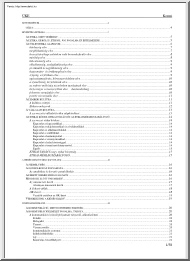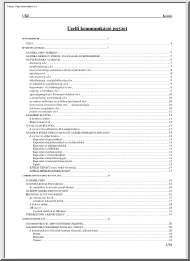Datasheet
Year, pagecount:2020, 2 page(s)
Language:English
Downloads:2
Uploaded:January 14, 2021
Size:1 MB
Institution:
-
Comments:
Attachment:-
Download in PDF:Please log in!
Comments
No comments yet. You can be the first!Most popular documents in this category
Content extract
Source: http://www.doksinet 0939 Annals of DAAAM for 2011 & Proceedings of the 22nd International DAAAM Symposium, Volume 22, No. 1, ISSN 1726-9679 ISBN 978-3-901509-83-4, Editor B. Katalinic, Published by DAAAM International, Vienna, Austria, EU, 2011 Make Harmony between Technology and Nature, and Your Mind will Fly Free as a Bird Annals & Proceedings of DAAAM International 2011 THE COMPETITIVE ADVANTAGE IN NEGOTIATION LUPU, A[drian] G[elu] & LUPU, F[elicia] Abstract: The importance of commercial negotiations has grown up in the same time with the growth of the interferences between national economics. Along with the development of the analyses for negotiation process, appear new questions to which the scientifically research have to answer. Protonegotiations mean discovering and applying new work methods during the negotiation or other ways to analyze the negotiation’s efficiency during the sales process. Innovation in negotiation means smoothing the process with
the protonegotiations’ help, according to the large number protonegotiations use. This study, first of all, sets out to characterize protonegotiations in the sales process and secondly, to analyze the protonegotiation’s share as sales promotion instrument. The study is an invitation to dialog to all the researchers or the ones who practice in the field, ready to implement innovation in the organization. Key words: protonegotiation, negotiations, strategic management, competitive environment rearranging “the chain of value”, changing the rules of the game, so it becomes necessary for the company to capitalize the distinct competencies and creates barriers in order to protect the advantage created (Doval, 2009). Companies that don’t innovate or at least apply innovation in their domain are going to continually suffer because of competitors. These competitors are going to use the whole sum of opportunity, capabilities, aptitudes and extra resources in order to obtain
competitive advantage and reach the named objective in front of the rival company. Competition is associated with competitive advantage. The competitive advantage is the company’s ability to have superior performance towards its competitors regarding the base objective of the existence, meaning profitability. The competitive advantage also represents the finality of implementing the differentiation process adopted by the companies’ management towards the markets novelties and evolution of the competition. The competitive environment’ differentiation refers to promoting what it is “unique” (Grant, 1998). 1. INTRODUCTION In the present context, each company has to worry about competition. The companies have to apply simultaneous strategies, which are going to be applied internally, alongside with business partners. These strategies are: combining exploitation and creation, entailing supply and research innovation, rational and emotional seek for imperfections (Ridderstrale
& Nordstrom, 2007). As it can be noticed, intelligent organizations realize that the innovation’s objective has systematic dimensions. Nowadays many organizations include their customers in developing new products and services. 2. THE INNOVATION AND THE COMPETITIVE ADVANTAGE The future will always take by surprise the companies that see innovation only as something that has to deal with the product or service from inside the organization. The innovation capacity refers to new ways to approach the business, to technical aspects regarding new ideas in creating the products and the services, to implementing new technologies. Innovation asks for imagination, intuition and creativity and less analysis in deductive sense. Anyhow, a careful examination of the way the companies compete can suggest changing opportunities. The change is not a negative, a degenerative process, but an inevitable and positive mean of evolution that leads the organization to adapt to the present and the
future reality in order to ensure the activity’s success (Grant, 1998). The change can be seen as an opportunity (being characterized through dynamism, flexibility, activity, motivation, stimulation), but also as a threat (characterized by stress, time and money consumption, anxiety, irritation, incertitude, failure). The specialists in management consultancy underline the fact that innovation refers to company reconfiguration, 3. PROTONEGOTIATION - THE NOVELTY IN NEGOTIATION Any negotiation implies an activity significantly orientated to another (Thuderoz, 2002). Beside negotiations, that involves meeting some authorized parts’ assignee, with an agenda and a common assigned procedure in order to reach an objective in the form of a written agreement, there is a permanent activity of tacit accommodation and attitude harmonization between the involved parts. In the absence of a formal and organized framework interferes, the activity which have the negotiations’ basic
characteristics is suggesting introducing the term of “protonegotiations”. Even though protonegotiations are taking place in the absence of the negotiators, distribution and media channels are used intensively in these activities. An important role is played by mass media publicity, the degree of penetration of commercials on the aimed companies, means and ways of sales promotion. When we protonegotiate, we negotiate with a partner that we don’t see and who doesn’t see us, probably we experience the same feeling we would feel if we were in a dialog with ourselves in an empty, dark room (Lupu, 2007). Protonegotiations consist in a one-sided act, taken as a signal by the interested parts. The signal is decoded, interpreted and commented on by the part that feels is being aimed. In this manner an arrangement can be reached without a formal agreement and without the negotiators to meet. In this situation, we encounter a simple example of product/ service promotion, where the
segment of clients is the final consumer, this being guided to the promoted product/service. Simple protonegotiation represents final consumers buying reaction, as an answer to the promotion stimulus of the product/service offered by the salesperson, under the conditions Source: http://www.doksinet 0940 and places already known or indicated in the promotion message of the product/service offered. Simple protonegotiations keep on continue being useful in the current and small proportion actions zone. Otherwise simple protonegotiation is an exception towards all the other protonegotiations, being the only transaction situation ending without a concrete negotiation taking place (providerbeneficiary, salesman-buyer) that would mark the agreement. The promoted product consumer agrees with the selling conditions without other negotiations taking place. In comparison with the simple protonegotiation situations, where the transaction is completed without the necessity for the parts to meet
and that can be approached as a distinct process with its own finality, complex protonegotiation is a distinct activity from a greater process that will end, ideally, through signing the agreement after all the other intermediary phases of the regular negotiations are lead. The protonegotiation that doesn’t limits itself at promoting a product/service, but is part of an ample campaign of communication and promotion where the transaction is not completed, being necessary, for other negotiations to take place, in the same time, between the partners in order to reach the buying agreement, indifferent to its nature, represents the complex protonegotiation. 4. PROTONEGOTIATION’S PROMOTION INSTRUMENT - SALES In the past, the sales force had to sell, sell and sell again (Kotler, 2005). Naturally, the ideal selling case, from the sales economic efficiency point of view, is when with low sales promotion costs they can close important transactions in volumes, values etc. In the recent
period of practice, where the sales procedures were formed not only by the sales itself, but also by the sales’ associated services like: service activities or technical assistance available for the customers, joining the traditional selling form through sale agents, shops or other kind of special set up spaces, proves that the salesperson’s efforts become greater and greater (Nicolescu & Verboncu, 2007). Selling a product without promotion, without marketing, will obviously become harder and harder, but by using protonegotiation techniques and tactics we communicate indirectly with the customer and we sell. That means we have negotiated! The whole communication activity can appear like a negotiation, because comprehension is possible (Deac, 2002). In protonegotiation context, the activity itself represents smoothing the path that the team of negotiators is going to follow, during the phases of the negotiation process. It is very important to mention that daily sales situations
don’t require building a team whose special task is negotiating a small agreement. Most of the times, in a concrete case, the team of negotiators counts only the sales agent or sales consultant, and in big sales cases the negotiation activity becomes the job of a team formed by the sales consultant and sales manager or area agent. In most cases, the size of the protonegotiations’ specific activities is directly proportioned with the size of the deal aimed to be closed. In the simple protonegotiations’ case, the bidder’s cost is reduced at the cost generated by mass media advertising and product promotion campaign. For complex protonegotiations, promotion is ample, divided on phases, starting from the possible image formation of the product, identifying consumers’ target segment, consumer education, keeping focus on the product, the examples can continue based on the complexity of the negotiation and the actual sale that is going to be achieved. The internet and the other
electronic communication forms have an important effect over the way the negotiation’s operations are managed and this aspect will be the most important challenge for the sales manager of tomorrow. Depending on the ability it is used, the negotiations and sales techniques’ knowledge degree, the protonegotiation activity can be also redirected for reaching intermediary objectives aimed by the negotiation team. The protonegotiation activity can also be oriented to mislead, in a negotiation, the other team on another channel, in order to distract them from a sensible objective that has to be negotiated, but which, normally would have required special abilities and techniques in order to reach them. We can also use protonegotiation to create a stronger image on the aimed objectives, which would determine the future partner to overbid the financial evaluation of the offer they are going to make. Even the acquisition budget of a company, once issued, well directed, can determine,
indirectly, the organization sales’ rise. Another evident example can be seen in the stock exchange field, meaning the way how the evolution of some stock exchange quotations is influenced when new information regarding that quotation appear. 5. CONCLUSION In a well organized protonegotiation campaign, closely prepared and achieving its goals, the information generated by the protonegotiative methods of sales analysis can be used in different analysis, studies, forecasts etc. It is obvious that the use in the analysis of the competitive environment of this innovation and the efficient balancing of its component parts could generate special savings of financial resource and time. The applicative dimensions of these methods are going to be analyzed comparatively with the already recognized analysis models. Far from being exhaustive, the study prove the importance of protonegotiations as sales method. 6. REFERENCES Deac, I.(2002) Introduction in theory of negotiation, Paideia, ISBN
973-596-118-0, Bucuresti Doval, E.(2009) Strategic analysis of competitive environment, Romania de Maine, ISBN 798-973-163-375-6, Bucuresti Grant, R.M(1998) Contemporary Strategy Analysis, Blackwell Business, ISBN 978-1-4051-6308-8,Oxford UK Kotler, Ph.(2005) Marketing Management EdIV, Teora, ISBN 1-59496-025-9, Bucuresti Lewicki, R.; Saunders, D & Barry, B(2006) Negotiation 5th edition, McGraw-Hill/Irvin, ISBN 007-124460-3, New York Lupu, A.G(2007), The efficiency of protonegotiations in commercial negotioations process, Preceedings of the seventh International Symposium Investments and Economic Recovery, May 25-27, 2007, Bucharest, ISBN 978-973-594952-5, Vasilescu, I.(Ed), pp 382-387, ASE, Bucuresti Lupu, A.G & Lupu, FA (2009) Evolution of complex sales in the service system, Economia–Seria Management, Vol. 12, no.2 special January 2009, pp 223-229, ISSN 1454-0320 Nicolescu, O. & Verboncu, I (2007) Organization Management, Economica, ISBN 978-973-709-343-1, Bucuresti
Prahalad, C. K & Hamel, G (1996) Competing for the Future, Harvard Business School Press, ISBN 0-87584-4162, Harvard Ridderstrale, J. & Nordstrom, K(2007) Karaoke Capitalism: Managing for Mankind, Publica, ISBN 978-973-88365-25, Bucuresti Shell, R.(2005) Bargaining for advantage : Negotiation strategies for reasonable people, Codecs, ISBN 973-806075-3, Bucuresti Thuderoz, Ch. (2000) Negociation Essai de sociologie du lien social, Presses Universitaires de France, ISBN 9975-67301-5, Paris
the protonegotiations’ help, according to the large number protonegotiations use. This study, first of all, sets out to characterize protonegotiations in the sales process and secondly, to analyze the protonegotiation’s share as sales promotion instrument. The study is an invitation to dialog to all the researchers or the ones who practice in the field, ready to implement innovation in the organization. Key words: protonegotiation, negotiations, strategic management, competitive environment rearranging “the chain of value”, changing the rules of the game, so it becomes necessary for the company to capitalize the distinct competencies and creates barriers in order to protect the advantage created (Doval, 2009). Companies that don’t innovate or at least apply innovation in their domain are going to continually suffer because of competitors. These competitors are going to use the whole sum of opportunity, capabilities, aptitudes and extra resources in order to obtain
competitive advantage and reach the named objective in front of the rival company. Competition is associated with competitive advantage. The competitive advantage is the company’s ability to have superior performance towards its competitors regarding the base objective of the existence, meaning profitability. The competitive advantage also represents the finality of implementing the differentiation process adopted by the companies’ management towards the markets novelties and evolution of the competition. The competitive environment’ differentiation refers to promoting what it is “unique” (Grant, 1998). 1. INTRODUCTION In the present context, each company has to worry about competition. The companies have to apply simultaneous strategies, which are going to be applied internally, alongside with business partners. These strategies are: combining exploitation and creation, entailing supply and research innovation, rational and emotional seek for imperfections (Ridderstrale
& Nordstrom, 2007). As it can be noticed, intelligent organizations realize that the innovation’s objective has systematic dimensions. Nowadays many organizations include their customers in developing new products and services. 2. THE INNOVATION AND THE COMPETITIVE ADVANTAGE The future will always take by surprise the companies that see innovation only as something that has to deal with the product or service from inside the organization. The innovation capacity refers to new ways to approach the business, to technical aspects regarding new ideas in creating the products and the services, to implementing new technologies. Innovation asks for imagination, intuition and creativity and less analysis in deductive sense. Anyhow, a careful examination of the way the companies compete can suggest changing opportunities. The change is not a negative, a degenerative process, but an inevitable and positive mean of evolution that leads the organization to adapt to the present and the
future reality in order to ensure the activity’s success (Grant, 1998). The change can be seen as an opportunity (being characterized through dynamism, flexibility, activity, motivation, stimulation), but also as a threat (characterized by stress, time and money consumption, anxiety, irritation, incertitude, failure). The specialists in management consultancy underline the fact that innovation refers to company reconfiguration, 3. PROTONEGOTIATION - THE NOVELTY IN NEGOTIATION Any negotiation implies an activity significantly orientated to another (Thuderoz, 2002). Beside negotiations, that involves meeting some authorized parts’ assignee, with an agenda and a common assigned procedure in order to reach an objective in the form of a written agreement, there is a permanent activity of tacit accommodation and attitude harmonization between the involved parts. In the absence of a formal and organized framework interferes, the activity which have the negotiations’ basic
characteristics is suggesting introducing the term of “protonegotiations”. Even though protonegotiations are taking place in the absence of the negotiators, distribution and media channels are used intensively in these activities. An important role is played by mass media publicity, the degree of penetration of commercials on the aimed companies, means and ways of sales promotion. When we protonegotiate, we negotiate with a partner that we don’t see and who doesn’t see us, probably we experience the same feeling we would feel if we were in a dialog with ourselves in an empty, dark room (Lupu, 2007). Protonegotiations consist in a one-sided act, taken as a signal by the interested parts. The signal is decoded, interpreted and commented on by the part that feels is being aimed. In this manner an arrangement can be reached without a formal agreement and without the negotiators to meet. In this situation, we encounter a simple example of product/ service promotion, where the
segment of clients is the final consumer, this being guided to the promoted product/service. Simple protonegotiation represents final consumers buying reaction, as an answer to the promotion stimulus of the product/service offered by the salesperson, under the conditions Source: http://www.doksinet 0940 and places already known or indicated in the promotion message of the product/service offered. Simple protonegotiations keep on continue being useful in the current and small proportion actions zone. Otherwise simple protonegotiation is an exception towards all the other protonegotiations, being the only transaction situation ending without a concrete negotiation taking place (providerbeneficiary, salesman-buyer) that would mark the agreement. The promoted product consumer agrees with the selling conditions without other negotiations taking place. In comparison with the simple protonegotiation situations, where the transaction is completed without the necessity for the parts to meet
and that can be approached as a distinct process with its own finality, complex protonegotiation is a distinct activity from a greater process that will end, ideally, through signing the agreement after all the other intermediary phases of the regular negotiations are lead. The protonegotiation that doesn’t limits itself at promoting a product/service, but is part of an ample campaign of communication and promotion where the transaction is not completed, being necessary, for other negotiations to take place, in the same time, between the partners in order to reach the buying agreement, indifferent to its nature, represents the complex protonegotiation. 4. PROTONEGOTIATION’S PROMOTION INSTRUMENT - SALES In the past, the sales force had to sell, sell and sell again (Kotler, 2005). Naturally, the ideal selling case, from the sales economic efficiency point of view, is when with low sales promotion costs they can close important transactions in volumes, values etc. In the recent
period of practice, where the sales procedures were formed not only by the sales itself, but also by the sales’ associated services like: service activities or technical assistance available for the customers, joining the traditional selling form through sale agents, shops or other kind of special set up spaces, proves that the salesperson’s efforts become greater and greater (Nicolescu & Verboncu, 2007). Selling a product without promotion, without marketing, will obviously become harder and harder, but by using protonegotiation techniques and tactics we communicate indirectly with the customer and we sell. That means we have negotiated! The whole communication activity can appear like a negotiation, because comprehension is possible (Deac, 2002). In protonegotiation context, the activity itself represents smoothing the path that the team of negotiators is going to follow, during the phases of the negotiation process. It is very important to mention that daily sales situations
don’t require building a team whose special task is negotiating a small agreement. Most of the times, in a concrete case, the team of negotiators counts only the sales agent or sales consultant, and in big sales cases the negotiation activity becomes the job of a team formed by the sales consultant and sales manager or area agent. In most cases, the size of the protonegotiations’ specific activities is directly proportioned with the size of the deal aimed to be closed. In the simple protonegotiations’ case, the bidder’s cost is reduced at the cost generated by mass media advertising and product promotion campaign. For complex protonegotiations, promotion is ample, divided on phases, starting from the possible image formation of the product, identifying consumers’ target segment, consumer education, keeping focus on the product, the examples can continue based on the complexity of the negotiation and the actual sale that is going to be achieved. The internet and the other
electronic communication forms have an important effect over the way the negotiation’s operations are managed and this aspect will be the most important challenge for the sales manager of tomorrow. Depending on the ability it is used, the negotiations and sales techniques’ knowledge degree, the protonegotiation activity can be also redirected for reaching intermediary objectives aimed by the negotiation team. The protonegotiation activity can also be oriented to mislead, in a negotiation, the other team on another channel, in order to distract them from a sensible objective that has to be negotiated, but which, normally would have required special abilities and techniques in order to reach them. We can also use protonegotiation to create a stronger image on the aimed objectives, which would determine the future partner to overbid the financial evaluation of the offer they are going to make. Even the acquisition budget of a company, once issued, well directed, can determine,
indirectly, the organization sales’ rise. Another evident example can be seen in the stock exchange field, meaning the way how the evolution of some stock exchange quotations is influenced when new information regarding that quotation appear. 5. CONCLUSION In a well organized protonegotiation campaign, closely prepared and achieving its goals, the information generated by the protonegotiative methods of sales analysis can be used in different analysis, studies, forecasts etc. It is obvious that the use in the analysis of the competitive environment of this innovation and the efficient balancing of its component parts could generate special savings of financial resource and time. The applicative dimensions of these methods are going to be analyzed comparatively with the already recognized analysis models. Far from being exhaustive, the study prove the importance of protonegotiations as sales method. 6. REFERENCES Deac, I.(2002) Introduction in theory of negotiation, Paideia, ISBN
973-596-118-0, Bucuresti Doval, E.(2009) Strategic analysis of competitive environment, Romania de Maine, ISBN 798-973-163-375-6, Bucuresti Grant, R.M(1998) Contemporary Strategy Analysis, Blackwell Business, ISBN 978-1-4051-6308-8,Oxford UK Kotler, Ph.(2005) Marketing Management EdIV, Teora, ISBN 1-59496-025-9, Bucuresti Lewicki, R.; Saunders, D & Barry, B(2006) Negotiation 5th edition, McGraw-Hill/Irvin, ISBN 007-124460-3, New York Lupu, A.G(2007), The efficiency of protonegotiations in commercial negotioations process, Preceedings of the seventh International Symposium Investments and Economic Recovery, May 25-27, 2007, Bucharest, ISBN 978-973-594952-5, Vasilescu, I.(Ed), pp 382-387, ASE, Bucuresti Lupu, A.G & Lupu, FA (2009) Evolution of complex sales in the service system, Economia–Seria Management, Vol. 12, no.2 special January 2009, pp 223-229, ISSN 1454-0320 Nicolescu, O. & Verboncu, I (2007) Organization Management, Economica, ISBN 978-973-709-343-1, Bucuresti
Prahalad, C. K & Hamel, G (1996) Competing for the Future, Harvard Business School Press, ISBN 0-87584-4162, Harvard Ridderstrale, J. & Nordstrom, K(2007) Karaoke Capitalism: Managing for Mankind, Publica, ISBN 978-973-88365-25, Bucuresti Shell, R.(2005) Bargaining for advantage : Negotiation strategies for reasonable people, Codecs, ISBN 973-806075-3, Bucuresti Thuderoz, Ch. (2000) Negociation Essai de sociologie du lien social, Presses Universitaires de France, ISBN 9975-67301-5, Paris





 When reading, most of us just let a story wash over us, getting lost in the world of the book rather than paying attention to the individual elements of the plot or writing. However, in English class, our teachers ask us to look at the mechanics of the writing.
When reading, most of us just let a story wash over us, getting lost in the world of the book rather than paying attention to the individual elements of the plot or writing. However, in English class, our teachers ask us to look at the mechanics of the writing.